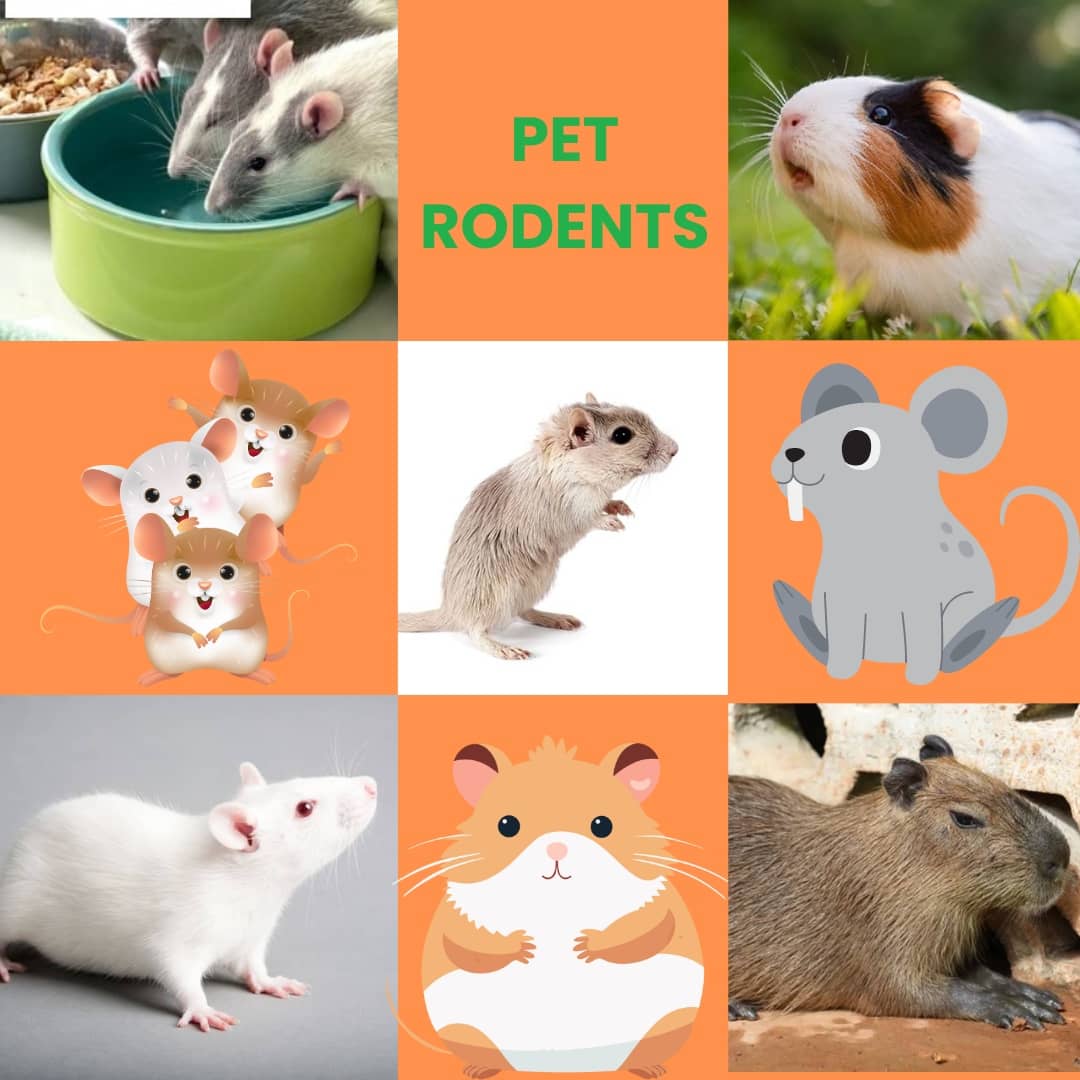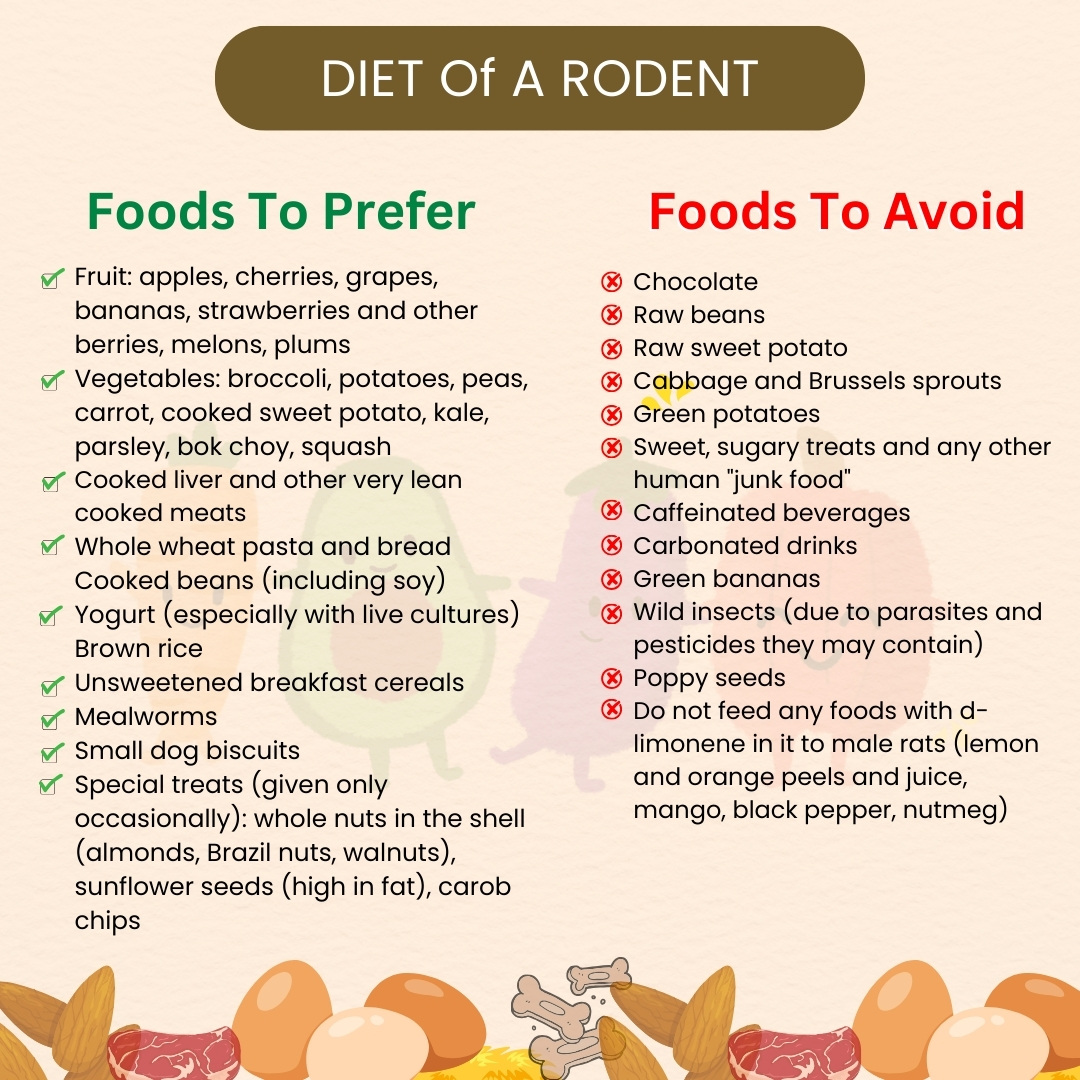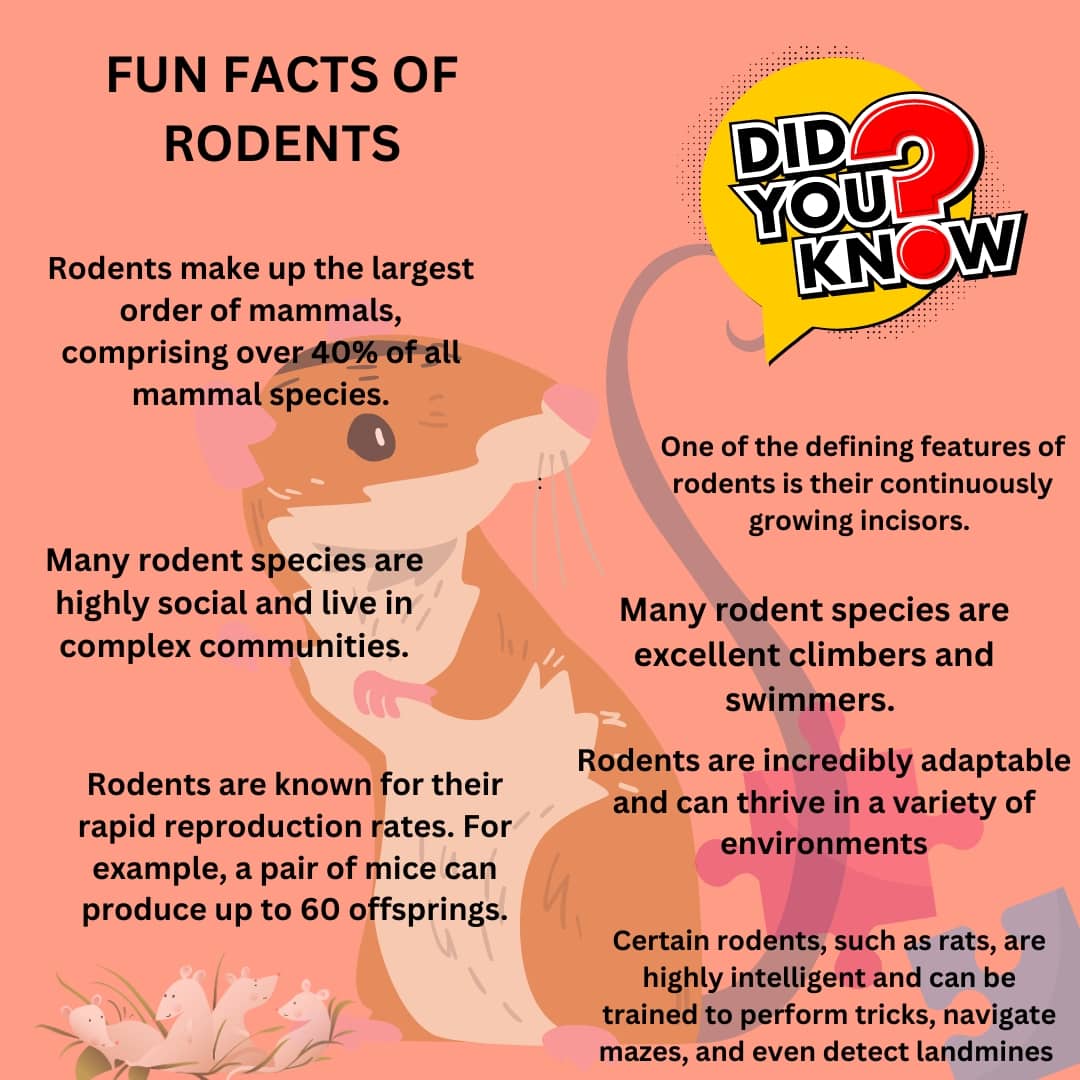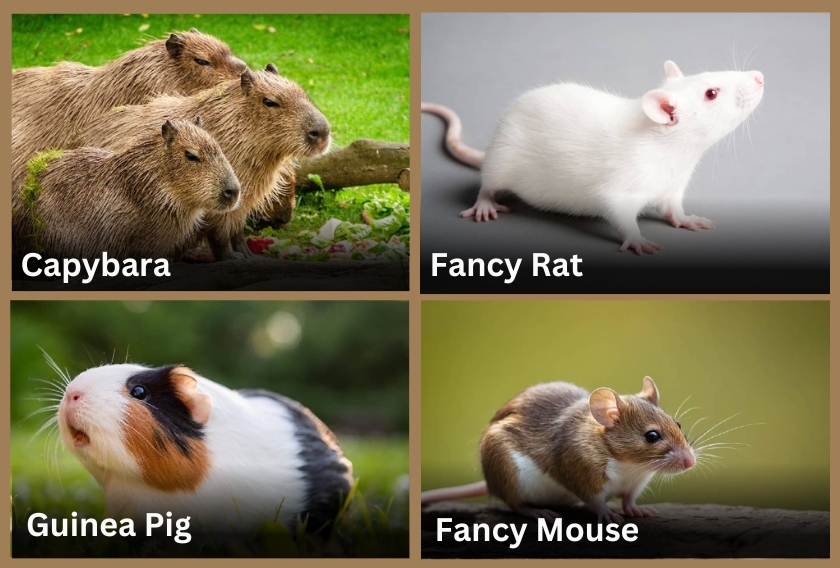What Are Rodents?
Rodents are a group of mammals known for their continuously growing incisors with a thick layer of enamel, which they need to gnaw to keep at manageable lengths.

Rodents are mammals of the order Rodentia, which are characterized by open-rooted, razor-sharp incisors for gnawing food and excavating burrows, and plant material.
The rodents are small animals with robust bodies, short limbs, and long tails. They have an adorable appearance with a cute face and fun-loving nature which make them ideal for an emotional support animal.
Common small pet rodents include mice, rats, hamsters, gerbils, and guinea pigs. These animals are generally easy to care for and inexpensive, making them popular choices for pets.
Size and Life Expectancy of Rodents
Their sizes vary from small mice to capybaras the size of pigs. The mice can be as small as 2.5-4” while a Rat can be 9-11” and a Capybara is of the size around 3.4 ft to 4.4 ft. The life expectancy also varies from 1 – 10 years for respective species.
Where Are the Rodents Found?
Except for Antarctica, New Zealand, and a few ocean islands, rodents are present all over the world. Numerous environments support them, including Grasslands, Tundra, Coniferous and Deciduous Forests, Wetlands, and Rainforests.
Behavior and Temperament of Rodents
Understanding your rodent’s behavior and temperament is crucial for a happy pet-owner relationship. Some rodents are social, active, and fun-loving. These curious creatures enjoy human interaction and learn some tricks. Hamsters are nocturnal and solitary whereas guinea pigs prefer living in groups.
Male Vs. Female Rodents
When choosing a pet rodent, you might wonder if there’s a significant difference between males and females. Generally, the choice between a male and female rodent can depend on the species. For instance:
Mice: Male mice can be more territorial and may exhibit more odor than females.
Rats: Both sexes are friendly, but males are typically larger and more laid back, while females are more active.
Hamsters: Female hamsters tend to be larger and may be more territorial than males.
Guinea Pigs: Both sexes are social, but males may sometimes exhibit more dominant behaviors.
The Good Side: Keeping Rodents as Pets
The rodents are preferred to be kept as pets due to certain reasons:
1. Low Maintenance
Rodents generally need less space than larger pets like dogs or cats, making them suitable for apartments or small homes. Most rodents groom themselves and require minimal grooming from their owners.
2. Cost Effective
The cost of purchasing a rodent and its initial setup (cage, bedding, food, toys) is usually lower than for larger pets. Regular costs for food, bedding, and occasional vet visits are generally affordable.
3. Variety of Species
There are many types of pet rodents to choose from, each with unique characteristics and needs, such as mice, rats, hamsters, gerbils, and guinea pigs. Each species and individual rodent can have a distinct personality, providing a range of experiences.
4. Bonding With Humans Makes Them ESA
Many rodents, especially rats and guinea pigs, can form strong bonds with their owners and enjoy interaction and play. Some rodents can be trained to do tricks or come when called, enhancing the pet-owner relationship.
An animal that offers a person with a mental health or psychiatric disability (like a severe mental illness) therapeutic benefits (like emotional support, comfort, or companionship) is known as an emotional support animal, or ESA.
5. Educational
Rodents can teach children responsibility, empathy, and the basics of animal care. They provide interesting opportunities to observe animal behavior and learn about biology.
The Bad Side: Keeping Rodents as Pets
The rodents are avoided to be kept as pets for the following reasons:
1. Short Lifespan
The relatively short lifespan can lead to frequent emotional losses, especially for children.
2. Health Concerns
Finding a vet specialized in small animals can be challenging, and some rodents are prone to specific health issues. Rodents are delicate creatures and can be easily injured, requiring careful handling.
3. Odor and Cleanliness
Rodent cages need regular cleaning to prevent odors and maintain a healthy environment.
Some rodents, like male mice, can produce strong odors.
4. Nocturnal Habits
Many rodents are nocturnal or crepuscular, meaning they are most active at night or dawn/dusk, which might not align with human schedules.
5. Social Needs
Some species, like guinea pigs and rats, thrive on social interaction and may become lonely or depressed without a companion. While generally low maintenance, rodents still require daily attention and interaction.
6. Escape Artists
Many rodents are adept at escaping their cages, requiring secure and escape-proof habitats.
7. Chewing and Destruction
Rodents need to gnaw to keep their teeth in check, which can lead to damage of cage accessories or, if they escape, household items.
How to Care for a Pet Rodent?
Small pet rodents make fantastic companions. They’re often low maintenance, highly entertaining, and have unique personalities. Whether you’re a seasoned pet owner or a first-timer, understanding the ins and outs of small pet rodents can help you provide the best care for your furry friends Let’s delve into various aspects of owning small pet rodents, from understanding what qualifies as a rodent to selecting the best species for pets, and much more.
1. Housing For A Rodent
Proper housing is essential for the health and well-being of your pet rodent. You will have to consider individual rodent species and check for specified information for housing your delicate rodent. For example, a multi-level cage with plenty of space for climbing and hiding is needed for mice, rats, and degu.
The cage for a hamster should have exercise wheels and tubes to explore. Moreover, you will have to provide hiding spots, deep bedding, and foraging food containers for the physical and mental stimulation of your little furry friend.
The size of the enclosure should be according to a particular rodent. A Capybara may need a zoo-like habitat with a custom pond, swamp, and marshy area whereas a hamster can be kept in a small enclosure.
Specific Substrate Needs
The type of bedding or nesting material may differ for a particular rodent. For example, a guinea pig finds fleece liner bedding more comfortable and mice, rats, and hamsters like paper-based bedding. However, you should avoid pine and cedar shavings in the bedding of your little friend as the oils secreted from these may pose a threat on the overall health of your pet.
2. Food and Nutrition of Your Rodent
Rodents have diverse diets depending on their species. While many are herbivorous, eating seeds, nuts, fruits, and vegetation, others have more varied diets that can include insects and small animals. Some, like the common rat, are omnivorous and highly opportunistic feeders.

You should provide a well-balanced and nutritious diet to your pet rodent. Species-specified food pellets, and high-quality rodent blocks supplemented with fresh fruits, and vegetables can provide essential nutrients to your pet rodent. The quantity of the food to be given depends upon the size, species, and age of your pet. Good quality hay should be given as a primary diet to some of the rodents such as guinea pigs and Capybaras.
3. Handling Your Pet Rodent
Some rodent species are friendly and love to be handled and some species which need some time to acclimate to human touch. Therefore you should never rush to handle your little furry friend, instead try to build trust by spending time, offering little treats, and gentle handling.
You should start with short handling sessions with young rodents to make them comfortable. While picking them up you should not startle them with sudden movements. You should scoop them gently and avoid grabbing them from the tail.
Best Rodent Pets for Beginners
The rodents are preferred to be kept as beginner pets due to various reasons. Some of the common Rodent pets are
1. Syrian hamster
The Syrian hamster, also known as the Golden hamster, is a rodent belonging to the subfamily Cricetinae. They were first discovered in Syria in the early 1930s and have since become beloved pets around the world.
With its endearing round body, twitching whiskers, and adorable button eyes, it’s no wonder why these tiny creatures have become such beloved pets worldwide.
The Syrian hamsters boast their beauty in every hue ranging from Golden umbrous, cinnamon, and dark grey to sliver grey, black, and white and with bands or patches of different colors. They have small rounded ears, large dark eyes, and stubby tails. Their soft and silky fur makes them more adorable to touch and pat.
2. Fancy mice
Fancy Mouse, a domesticated variety of the common house mouse are popular pets known for their curious and friendly nature. The scientific name of a fancy mouse is (Mus musculus).
It is a pocket pet species artificially bred in a variety of colors and coat patterns, adding to their appeal. They come in colors of black, chocolate, blue, white, cream, lilac, fawn, cinnamon, golden agouti, silver agouti, and dove.
A large head, large eyes, tulip-shaped ears, and a long hairless tail make them distinguished creatures. The eyes are at the head’s sides, giving them a panoramic view. They are also available with different markings such as even-marked, broken-marked, banded mice, and many more. These markings on their body give them an adorable look.
3. Fancy Rat
The Pet Fancy Rats are popular pets because they are curious, intelligent, clean, friendly, and trainable.
The Fancy Rat (Rattus Norvegicus domestica) is a domesticated rodent that is popular with many names such as Common Rat, Brown Rat, Sewer Rat, Hanover Rat, Norwegian Rat, and Wharf Rat.
The two varieties of Fancy Rats are the Black Rat(Rattus Rattus) and the Brown Rat(Rattus Norvegians). These are popular pets known for their curious and friendly nature.
It is a pocket pet species artificially bred in a variety of colors and coat patterns, adding to their appeal. They come in colors of white, cinnamon, blue, black, beige, fawn, and chocolate. The agouti coloring rats have three tones of colors on the same hair.
4. Gerbil
Gerbils are mammals from the Rodentia order, with the scientific name, Meriones Unguiculatus. These rodents belong to the Muridae family subfamily Gerbillinae and are known for their friendly demeanor, inquisitive nature, and boundless energy.
Although there are many gerbil species in the wild, Mongolian gerbils are the most common breed used as pets. Their general hue is gray in the wild but after selective breeding, these are nurtured in brown, gray, red, white, orange, pink, and olive colors as well.
The Gerbils have a thick coat of soft fur. The gerbil’s back feet are long and narrow to assist them in jumping and long claws help them to dig.
The Mongolian Gerbils are also known as “Clawed jirds”, “Clawed femur” and “Small Clawed Warrior”.
They have excellent hearing power and considerably good vision.
5. Guinea pig
The Guinea pig is a species of rodent belonging to the genus Cavia in the family Caviidae with the scientific name, Cavia Porcellus. These small, cute, and attractive creatures have a docile temperament that makes them a good choice to be kept as pets.
There are around 20 breeds of domestic Guinea pigs such as Texel Guinea pig, Teddy Guinea pig, Peruvian Guinea pig, Peruvian Satin, American, American Satin, Silkie, and Silkie Satin.
Their short limbs, large head, and eyes with short ears give them an adorable look. There are also short hair and long-haired Guinea pigs who require a little bit different care in terms of grooming. They come in various breeds and colors, each with a unique personality and characteristics. They are in attractive hues ranging from white, cream, tan, reddish-brown, olive, cinnamon, brown, black, or a combination of some colors.
6. Chinchilla
Chinchilla lanigera and Chinchilla chinchilla, are two species of rodents out of which Chinchilla chinchilla is on the verge of extinction. However, C. lanigera is the species that includes domesticated chinchillas.
The Chinchilla lanigera is a furry creature with a thinner body, longer tail, and larger ears than the C. Chinchilla.
Some people keep domestic chinchillas as pets, which are descended from C. lanigera and can be categorized as a kind of pocket pet. The average size of their body is 9-14” with a nearly 3-6” long tail. The females are slightly larger than their male counterparts. The average weight of Chinchilla is around 500-700g.
They are renowned for their soft, dense fur, which comes in a variety of colors, including gray, white, black, ebony, violet, and beige. The Chinchilla’s coat is very thick and protects them from extreme cold. Their soft and dense fur makes them more vulnerable to hunting as their fur is used in making fabric.
7. Degu
Degu is a small rodent with a bubbly personality native to Chile. It is a rat-like species but larger than a hamster and smaller than a fancy rat. A large head, large eyes, dark sparsely furred ears, pale grey toes, and a long thin tail with a tufted black tip characterize the Degu.
The Degu has a body length of nearly 25- 31cm (9.8-12.2”) with a weight ranging between 170g-400g(6- 14.10Oz). The life span of Degu is nearly 6-8 years in captivity but it can be longer with proper care and handling.
The Degu is found in various colors of yellow, brown, golden, silver, and grey. The color of the fur has a different shade around the neck and areas near the eyes.
8. Capybara
The Capybara is a semiaquatic mammal native to Central and South America. The Capybaras are the largest living rodents and love to live in scrublands, swamps, marshes, and Savannas. Their scientific name is Hydrochoerus Hydrochaeris, which means ” Water Hog” in Latin.
They have a heavy barrel-shaped body with a short head, small ears, short legs, and vestigial tail.
These adorable animals have a distinctive look with their large bodies, webbed feet, and a coat that ranges from dark brown to reddish fur on the upper part of their body and yellowish-brown underneath.
Ethical Considerations For Keeping A Rodent
Owning a pet rodent comes with ethical responsibilities. Ensuring your pet’s well-being means providing adequate space, social interaction, and appropriate healthcare. Avoid supporting breeders who engage in unethical practices, and consider adopting from rescues or shelters.
Legal Aspects For Keeping A Rodent
Before bringing a rodent into your home, check local regulations. Some areas have restrictions on keeping certain species. For example, some types of hamsters and gerbils might be illegal in certain states due to concerns about them becoming invasive species.
Health Concerns Of Your Pet Rodent
There are some potential health concerns related to your pet rodent. You should be vigilant to check for changes in the behavior so that you can take necessary preventive steps.
1. Respiratory Infections
If you find your rodent Sneezing, wheezing, having nasal discharge, or under labored breathing, it may have caught some bacterial infections. It may be due to poor ventilation, and dusty bedding.
Prevention and Treatment: Maintain a clean, well-ventilated living environment, use low-dust bedding, and seek veterinary care for antibiotics if an infection is suspected.
2. Dental Problems
If your rodent has overgrown incisors and facing difficulty in eating or having facial swelling, it may need trimming of incisors. Lack of gnawing materials, and genetic factors may be the cause.
Prevention and Treatment: Provide chew toys and hard foods to help keep teeth worn down. Regularly check your rodent’s teeth, and seek veterinary care for trimming if necessary.
3. Skin Issues
Due to parasites (mites or lice) or fungal infections (ringworm), allergies, and poor hygiene can lead to hair loss, itching, redness, scabs, and abnormal skin lumps.
Prevention and Treatment: You should keep the living environment clean, use appropriate bedding, and treat any parasites promptly and consult a vet for antifungal or anti-parasitic treatments.
4. Gastrointestinal Problems
Poor diet, sudden diet changes, bacterial or viral infections, and ingestion of toxic substances can lead to loss of appetite, weight loss, and lethargy of your pet rodent.
Prevention and Treatment: You should provide a balanced diet suitable for your rodent species, and ensure fresh water is always available. You should seek veterinary care for severe or persistent symptoms.
5. Tumors and Cancer
If there are visible lumps or bumps, weight loss, and changes in behavior or eating habits then you should get your rodent a thorough check-up from a veterinarian.
Prevention and Treatment: Regularly check your rodents for lumps and monitor their overall health. Early detection is crucial, so consult a veterinarian if you notice any abnormalities. Treatment options may include surgical removal of tumors, although not all tumors are operable.
Where To Buy Rodents?
You should get pet rodents from rescue shelters or reputed and authentic breeders. While bringing a furry friend at home ensure that it is in good health. You can get details of its age, gender and location from where it is rescued. It will help you to take its good care.
- Petco: A leading pet retail chain offering a variety of products and services, including a selection of tarantulas for sale alongside other pets and pet supplies.
Interesting and Popular Facts About Rodents
Rodents are fascinating creatures with many unique characteristics. Here are ten interesting and popular facts about rodents:
- Diverse Group : Rodents make up the largest order of mammals, comprising over 40% of all mammal species. There are more than 2,000 species of rodents, ranging from tiny mice to large capybaras.
- Continuously Growing Teeth: One of the defining features of rodents is their continuously growing incisors. They must constantly gnaw on objects to keep their teeth from growing too long.
- Highly Adaptable: Rodents are incredibly adaptable and can thrive in a variety of environments. They are found on every continent except Antarctica and have successfully adapted to urban, suburban, and rural areas. The aquatic rodents have webbed feet for swimming.
- Prolific Breeders: Rodents are known for their rapid reproduction rates. For example, a pair of mice can produce up to 60 offspring in a single year.
- Intelligent and Trainable: Certain rodents, such as rats, are highly intelligent and can be trained to perform tricks, navigate mazes, and even detect landmines or diseases.
- Social Animals: Many rodent species are highly social and live in complex communities. For example, rats and guinea pigs form strong social bonds and exhibit behaviors such as grooming and playing with each other. Social interaction is crucial for their well-being.
- Communication: Rodents use a variety of methods to communicate with each other, including vocalizations, scent markings, and body language.
- Variety of Diets: Rodents have diverse diets depending on their species. While many are herbivorous, eating seeds, nuts, fruits, and vegetation.
- Exceptional Climbers and Swimmers: Many rodent species are excellent climbers and swimmers.
- Tail Facts: The long tail of rodents helps them to maintain balance while climbing on narrow paths such as ropes. It also helps them to regulate their body temperature.

Frequently Asked Questions
Question 1: What is the best type of rodent to be kept as a beginner pet?
Answer: A hamster or guinea pig is a better choice to be kept as a beginner pet.
Question2: What do all rodents have in common?
Answer: The overgrowing incisors are common in all rodents.
Question 3: Where do all rodents live?
Answer: Rodents are found all over the world except the regions of Antarctica, New Zealand, and some ocean Islands.
Question 4: Are rodents legal pets in the USA?
Answer: It is legal to keep some rodents as pets. But there are some varieties such as Capybara which is illegal to be kept as a pet in California and Georgia.
Question 5: What category is a rodent in?
Answer: Rodents are the mammals from the order Rodentia. The Rodentia also includes beavers, muskrats, porcupines, woodchucks, chipmunks, squirrels, prairie dogs, marmots, chinchillas, voles, lemmings, and many others.
Question 6: Are rodents good pets for living in small apartments?
Answer: The rodents are small in size, and require small enclosures. Therefore they are apt for living in small apartments.
Question 7: What is the lifespan of rodents?
Answer: In captivity, the lifespan of rodents is 1-10 years.
Question 8: What sound do rodents make?
Answer: Rodents are incredibly vocal animals and communicate using barks, chirps, whistles, huffs, and purrs.
Question 9: Name the largest rodent.
Answer: A capybara is the largest rodent and takes size in the range of 3.4 ft to 4.4 ft. They can weigh between 77 to 146 pounds.
Question 10: What do rodents eat?
Answer: They primarily eat grass, vegetables, and specially formulated pellets. Some rodents are omnivores and eat insects, mealworms and cooked- egg.
Conclusion
Rodents are a diverse and intriguing group of mammals with remarkable adaptations that have allowed them to thrive in various environments. Their intelligence, social behaviors, and ecological importance make them fascinating subjects for study and popular pets for many animal lovers. Understanding these unique characteristics helps us appreciate the vital role rodents play in our world.

